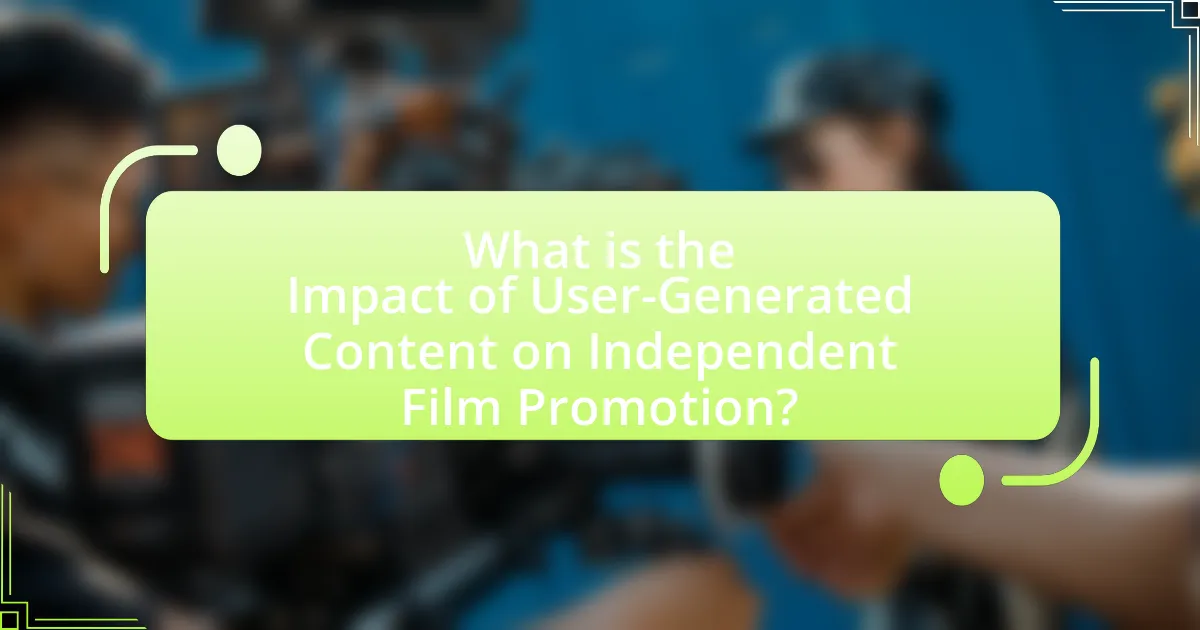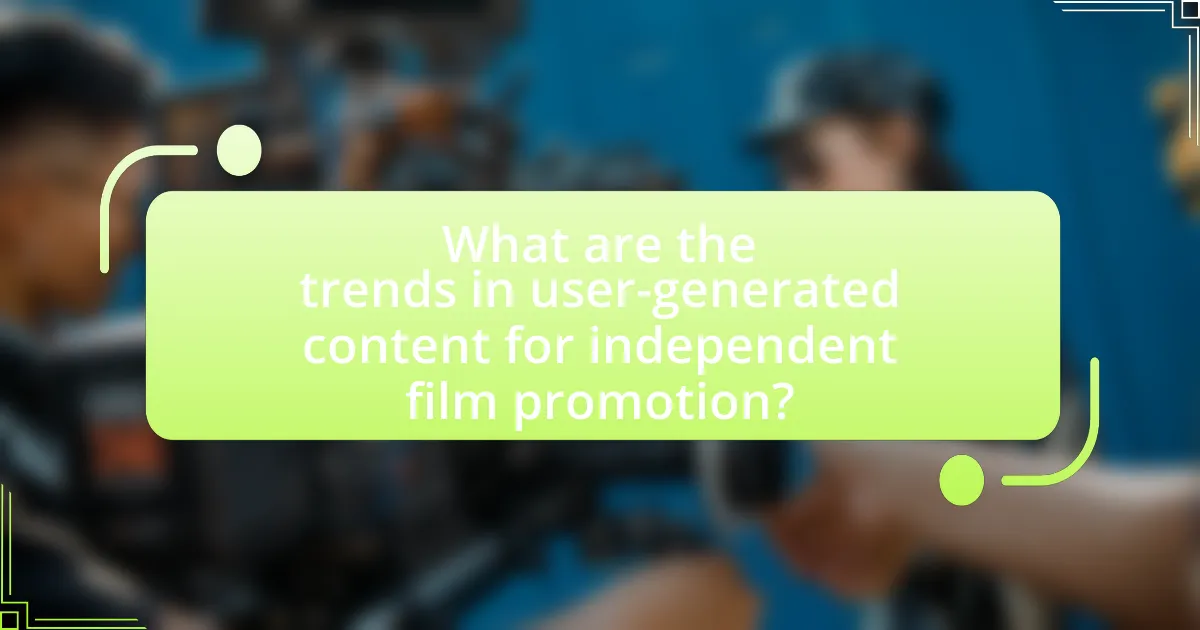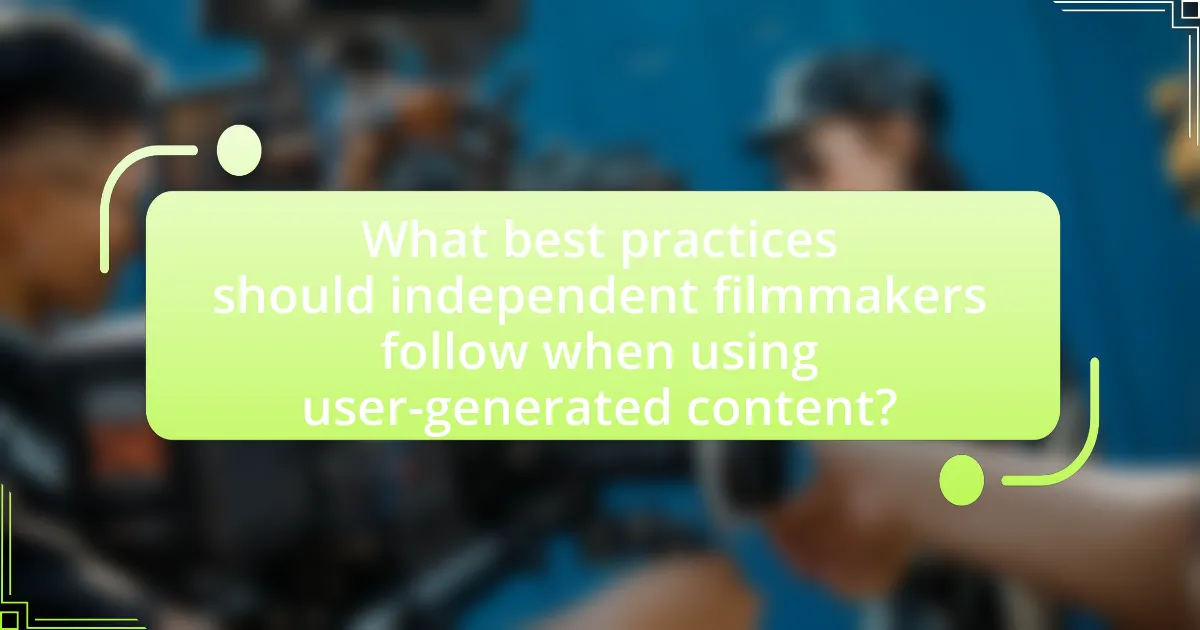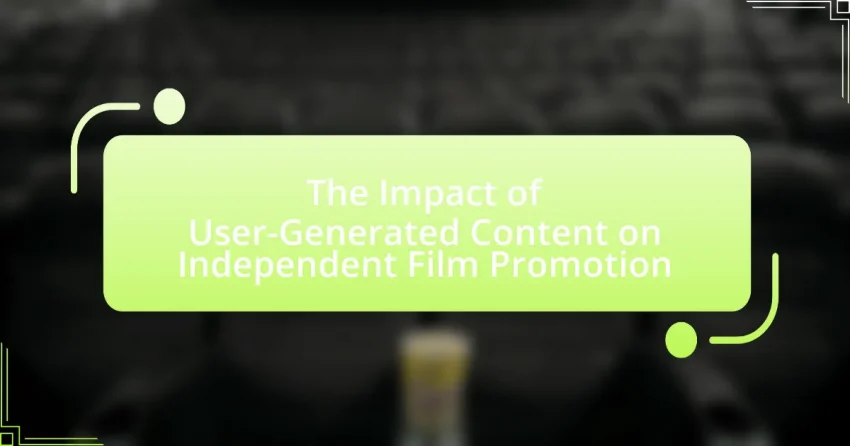User-generated content (UGC) plays a crucial role in promoting independent films by enhancing audience engagement and expanding reach. This article examines how UGC, including social media posts, reviews, and fan-created content, fosters community and authenticity, leading to increased box office revenue and viewer turnout. It also explores the effectiveness of UGC compared to traditional marketing methods, the importance of authenticity, and strategies for filmmakers to leverage UGC while addressing challenges such as quality control and copyright issues. Additionally, the article highlights successful case studies and best practices for independent filmmakers to effectively utilize UGC in their promotional efforts.

What is the Impact of User-Generated Content on Independent Film Promotion?
User-generated content significantly enhances independent film promotion by increasing audience engagement and expanding reach. This type of content, such as reviews, social media posts, and fan-made trailers, creates a sense of community and authenticity around the film, which is crucial for independent projects that often lack large marketing budgets. According to a study published in the Journal of Marketing Research, films with higher levels of user-generated content saw a 20% increase in box office revenue compared to those with minimal user engagement. This demonstrates that user-generated content not only fosters a loyal fan base but also drives financial success for independent films.
How does user-generated content influence audience engagement in independent films?
User-generated content significantly enhances audience engagement in independent films by fostering a sense of community and personal investment among viewers. This engagement is driven by the interactive nature of platforms where audiences can share their thoughts, reviews, and creative interpretations of the films, which in turn encourages others to participate and discuss. For instance, a study by the University of Southern California found that films with active social media discussions and user-generated content saw a 30% increase in audience turnout compared to those without such engagement. This demonstrates that user-generated content not only amplifies visibility but also cultivates a loyal viewer base, ultimately leading to greater success for independent films.
What types of user-generated content are most effective for promoting independent films?
User-generated content that is most effective for promoting independent films includes social media posts, reviews, fan art, and video testimonials. Social media posts, particularly those shared on platforms like Instagram and TikTok, can generate buzz and reach a wider audience, as evidenced by the success of films like “The Blair Witch Project,” which utilized grassroots marketing strategies. Reviews on platforms such as Rotten Tomatoes and IMDb can enhance credibility and attract viewers, with studies showing that positive user reviews significantly influence film choices. Fan art engages the community and fosters a sense of ownership, while video testimonials provide authentic endorsements that resonate with potential viewers. Collectively, these types of content leverage the power of community engagement and authenticity, driving interest and viewership for independent films.
How does user-generated content compare to traditional marketing methods for independent films?
User-generated content (UGC) is often more effective than traditional marketing methods for independent films due to its authenticity and engagement potential. UGC, such as reviews, social media posts, and fan-made trailers, fosters a sense of community and trust among audiences, which can lead to higher viewer interest and attendance. In contrast, traditional marketing methods, like print ads and television commercials, typically lack the personal touch and relatability that UGC provides.
Research indicates that 79% of consumers say user-generated content highly impacts their purchasing decisions, highlighting its persuasive power. Additionally, independent films often operate with limited budgets, making UGC a cost-effective alternative to expensive traditional marketing campaigns. By leveraging platforms like social media, independent filmmakers can tap into organic reach and word-of-mouth promotion, which are crucial for their visibility in a crowded market.
Why is user-generated content important for independent filmmakers?
User-generated content is important for independent filmmakers because it enhances visibility and engagement with their audience. Independent filmmakers often operate with limited marketing budgets, making user-generated content a cost-effective way to promote their films. For instance, platforms like social media allow fans to share their experiences and opinions, which can lead to organic word-of-mouth promotion. According to a study by the Pew Research Center, 72% of adults use social media, providing a vast audience for filmmakers to reach through user-generated content. This engagement not only builds a community around the film but also fosters a sense of authenticity and relatability, which can significantly influence potential viewers’ decisions to watch the film.
What role does authenticity play in user-generated content for film promotion?
Authenticity significantly enhances user-generated content (UGC) for film promotion by fostering trust and engagement among audiences. When users create content that reflects genuine experiences or opinions about a film, it resonates more deeply with potential viewers, leading to increased interest and viewership. Research indicates that 79% of consumers say user-generated content highly impacts their purchasing decisions, demonstrating the persuasive power of authentic voices in marketing. Furthermore, authentic UGC often leads to higher levels of sharing and interaction on social media platforms, amplifying the film’s reach and visibility.
How can independent filmmakers leverage user-generated content to build a community?
Independent filmmakers can leverage user-generated content (UGC) to build a community by encouraging audience participation and fostering engagement through social media platforms. By inviting fans to create and share their own content related to the film, such as reviews, fan art, or behind-the-scenes footage, filmmakers can create a sense of ownership and connection among viewers. This approach not only enhances the visibility of the film but also cultivates a loyal fan base, as evidenced by the success of campaigns like the “Star Wars” fan films, which have generated extensive community involvement and discussion. Engaging with UGC allows filmmakers to tap into the creativity of their audience, thereby strengthening community ties and promoting the film organically.
What challenges do independent filmmakers face with user-generated content?
Independent filmmakers face significant challenges with user-generated content, primarily concerning quality control and copyright issues. The influx of user-generated content can lead to a dilution of brand identity, as filmmakers struggle to maintain a consistent message and aesthetic amidst diverse contributions. Additionally, copyright infringement poses a risk, as filmmakers may inadvertently use content that violates intellectual property rights, leading to potential legal disputes. According to a study by the University of Southern California, 70% of independent filmmakers reported concerns about unauthorized use of their work in user-generated content, highlighting the pervasive nature of this issue.
How can filmmakers manage negative user-generated content effectively?
Filmmakers can manage negative user-generated content effectively by actively monitoring online platforms and engaging with audiences to address concerns. This proactive approach allows filmmakers to identify negative feedback early and respond constructively, which can mitigate potential damage to their film’s reputation. Research indicates that 70% of consumers are more likely to support a brand that responds to negative comments, highlighting the importance of engagement. By acknowledging criticism and providing clarifications or solutions, filmmakers can turn negative interactions into opportunities for positive dialogue, ultimately enhancing their film’s promotion and audience perception.
What legal considerations should filmmakers be aware of regarding user-generated content?
Filmmakers must be aware of copyright, licensing, and liability issues when using user-generated content. Copyright law protects original works, meaning filmmakers need permission from content creators to use their material. Additionally, filmmakers should consider licensing agreements to clarify usage rights and avoid potential legal disputes. Liability concerns arise if user-generated content includes defamatory statements or infringes on privacy rights, which can lead to lawsuits. Understanding these legal considerations is crucial for filmmakers to mitigate risks and ensure compliance with intellectual property laws.
How can independent filmmakers effectively utilize user-generated content?
Independent filmmakers can effectively utilize user-generated content by encouraging audience participation through social media campaigns and contests that invite fans to create and share their own content related to the film. This strategy not only increases engagement but also expands the film’s reach, as user-generated content often garners more attention and authenticity than traditional marketing methods. For instance, a study by the Pew Research Center found that 72% of internet users engage with user-generated content, highlighting its potential to enhance visibility and foster community around a film. By leveraging platforms like Instagram, TikTok, and YouTube, independent filmmakers can tap into existing fan bases and create a sense of ownership among viewers, ultimately driving interest and ticket sales.
What strategies can filmmakers implement to encourage user-generated content creation?
Filmmakers can encourage user-generated content creation by implementing interactive campaigns that invite audience participation. For instance, they can host contests that reward fans for creating and sharing their own content related to the film, such as fan art, videos, or social media posts. A successful example is the “Star Wars: The Force Awakens” campaign, which encouraged fans to share their own stories and artwork, resulting in a significant increase in engagement and content creation. Additionally, filmmakers can leverage social media platforms to create dedicated hashtags, making it easier for users to share their content and for filmmakers to track and promote this user-generated material. This strategy not only fosters community involvement but also amplifies the film’s reach through organic sharing.
How can filmmakers measure the success of user-generated content in their promotional efforts?
Filmmakers can measure the success of user-generated content (UGC) in their promotional efforts through metrics such as engagement rates, reach, and conversion rates. Engagement rates can be assessed by analyzing likes, shares, comments, and interactions on social media platforms where UGC is shared. For instance, a study by the Content Marketing Institute found that user-generated content can lead to a 28% increase in engagement compared to brand-generated content.
Reach can be quantified by tracking the number of unique views or impressions that UGC receives across various channels. Additionally, conversion rates can be evaluated by monitoring how many viewers of UGC take desired actions, such as purchasing tickets or streaming the film, which can be tracked through specific links or promotional codes associated with the UGC.
By combining these metrics, filmmakers can gain a comprehensive understanding of how effectively user-generated content contributes to their promotional strategies.

What are the trends in user-generated content for independent film promotion?
Trends in user-generated content for independent film promotion include increased engagement through social media platforms, the use of fan-created trailers and posters, and the rise of crowdfunding campaigns that leverage user-generated content for marketing. Social media platforms like Instagram and TikTok have become essential for independent filmmakers, allowing them to share behind-the-scenes content and engage directly with audiences, which fosters a sense of community and investment in the film. Additionally, fan-created content, such as trailers and artwork, not only promotes the film but also enhances its visibility and authenticity, as seen in successful campaigns for films like “The Blair Witch Project.” Crowdfunding platforms, such as Kickstarter, often encourage backers to create promotional content, further integrating user-generated content into the marketing strategy. These trends demonstrate how independent films increasingly rely on audience participation to build momentum and reach wider audiences.
How is social media shaping the landscape of user-generated content in film promotion?
Social media is significantly shaping the landscape of user-generated content in film promotion by enabling filmmakers and audiences to interact directly, fostering community engagement and organic marketing. Platforms like Instagram, Twitter, and TikTok allow users to create and share content related to films, such as fan art, reviews, and trailers, which can reach vast audiences quickly. For instance, a study by the Pew Research Center found that 69% of adults in the U.S. use social media, making it a powerful tool for independent filmmakers to leverage user-generated content for promotional purposes. This shift has led to a democratization of film marketing, where traditional advertising is supplemented or even replaced by authentic content created by fans, enhancing visibility and credibility for independent films.
What platforms are most popular for sharing user-generated content related to independent films?
The most popular platforms for sharing user-generated content related to independent films are YouTube, Instagram, and TikTok. YouTube serves as a primary hub for trailers, reviews, and fan-made content, with over 2 billion monthly users, making it a vital space for independent filmmakers to reach audiences. Instagram, with its visual-centric approach, allows filmmakers and fans to share promotional images, behind-the-scenes content, and short clips, leveraging its 1 billion active users to create buzz around independent films. TikTok has rapidly gained popularity for its short-form video content, enabling users to create engaging and viral clips that can significantly boost visibility for independent films, especially among younger demographics. These platforms collectively enhance the promotion and visibility of independent films through user-generated content.
How do emerging technologies influence user-generated content in film marketing?
Emerging technologies significantly enhance user-generated content in film marketing by providing platforms and tools that facilitate content creation and distribution. For instance, social media platforms like Instagram and TikTok enable users to create and share film-related content, such as reviews, fan art, and trailers, reaching vast audiences quickly. According to a 2021 report by Statista, 54% of consumers engage with user-generated content when making purchasing decisions, indicating its influence on film marketing effectiveness. Additionally, advancements in mobile technology allow users to produce high-quality videos and graphics, further enriching the content landscape and driving engagement for independent films.
What case studies illustrate successful use of user-generated content in independent film promotion?
One notable case study illustrating successful use of user-generated content in independent film promotion is the campaign for the film “Tangerine.” The filmmakers encouraged audiences to share their experiences and reactions on social media, which resulted in a significant online buzz and increased visibility. This grassroots approach led to “Tangerine” grossing over $1 million at the box office, a remarkable achievement for an independent film with a modest budget. Another example is the promotion of “The Blair Witch Project,” where the filmmakers utilized a website that featured user-generated content, including fake news articles and testimonials, creating a viral marketing effect that contributed to its $248 million worldwide gross. These case studies demonstrate how user-generated content can effectively engage audiences and enhance the promotional efforts of independent films.
What lessons can be learned from successful independent films that utilized user-generated content?
Successful independent films that utilized user-generated content demonstrate the importance of community engagement and authenticity in promotion. These films often leverage social media platforms to encourage audience participation, which fosters a sense of ownership and connection among viewers. For instance, films like “Tangerine” effectively used platforms like Instagram to share behind-the-scenes content and engage with fans, resulting in increased visibility and word-of-mouth promotion. Additionally, user-generated content can enhance storytelling by incorporating diverse perspectives, as seen in projects like “The Blair Witch Project,” which utilized grassroots marketing strategies that resonated with audiences. This approach not only builds a loyal fan base but also creates a more relatable narrative, ultimately contributing to the film’s success.
How did specific campaigns leverage user-generated content to achieve their goals?
Specific campaigns leveraged user-generated content (UGC) by encouraging audience participation to enhance engagement and promote their films. For instance, the “Blair Witch Project” campaign utilized UGC by creating a website that featured fake documentary-style content, inviting fans to contribute their own theories and experiences, which generated buzz and intrigue around the film. Similarly, the “Trolls World Tour” campaign encouraged fans to share their own dance videos using the film’s music, resulting in a viral trend that increased visibility and excitement for the movie. These strategies effectively harnessed the creativity and enthusiasm of the audience, leading to increased awareness and box office success.

What best practices should independent filmmakers follow when using user-generated content?
Independent filmmakers should obtain explicit permission from content creators before using user-generated content (UGC) to avoid legal issues. This practice ensures that filmmakers respect copyright laws and the rights of individuals who created the content. Additionally, filmmakers should credit the original creators to foster goodwill and encourage further engagement. According to a study by the University of Southern California, proper attribution can enhance audience trust and increase the likelihood of sharing content. Furthermore, filmmakers should consider the context in which the UGC was created to ensure it aligns with their film’s message and branding, as misalignment can lead to audience confusion or backlash.
How can filmmakers create guidelines for user-generated content submissions?
Filmmakers can create guidelines for user-generated content submissions by establishing clear criteria that outline acceptable content types, submission formats, and legal considerations. These guidelines should specify the themes, styles, and formats that align with the film’s vision, ensuring that submissions enhance the promotional strategy. For instance, filmmakers can require that videos be no longer than two minutes and focus on specific aspects of the film, such as character analysis or thematic exploration. Additionally, legal guidelines should address copyright issues, requiring that all submissions are original and do not infringe on third-party rights. By providing these structured guidelines, filmmakers can effectively curate user-generated content that supports their promotional efforts while maintaining quality and relevance.
What are the key elements of a successful user-generated content campaign for independent films?
The key elements of a successful user-generated content campaign for independent films include clear objectives, audience engagement, incentivization, and effective distribution channels. Clear objectives help define the campaign’s purpose, such as increasing awareness or driving ticket sales. Audience engagement is crucial, as it encourages fans to create and share content related to the film, fostering a sense of community. Incentivization, such as contests or rewards, motivates participation and enhances content creation. Effective distribution channels, including social media platforms and film-related forums, ensure that user-generated content reaches a wider audience, amplifying its impact. These elements collectively contribute to the campaign’s success by leveraging the power of community-driven promotion.
How can filmmakers maintain engagement with their audience through user-generated content?
Filmmakers can maintain engagement with their audience through user-generated content by actively encouraging and showcasing audience contributions, such as fan art, reviews, and social media posts. This strategy fosters a sense of community and belonging among viewers, as they feel their input is valued and recognized. For instance, a study by the Pew Research Center found that 72% of teens engage with user-generated content, indicating its popularity and potential to enhance audience interaction. By integrating user-generated content into marketing campaigns and social media platforms, filmmakers can create a dynamic dialogue with their audience, ultimately leading to increased loyalty and interest in their projects.
What practical tips can independent filmmakers implement for user-generated content success?
Independent filmmakers can enhance user-generated content success by actively engaging their audience through social media platforms. By creating dedicated hashtags and encouraging fans to share their experiences, filmmakers can foster a community that generates organic content. For instance, a study by the Pew Research Center indicates that 72% of adults use social media, making it a vital tool for reaching potential viewers. Additionally, filmmakers should provide clear guidelines for content creation, ensuring that submissions align with their vision while allowing creative freedom. This approach not only increases the quantity of user-generated content but also maintains quality, as seen in successful campaigns like the “Ice Bucket Challenge,” which generated millions of user videos.
How can filmmakers encourage audience participation in user-generated content creation?
Filmmakers can encourage audience participation in user-generated content creation by implementing interactive campaigns that invite viewers to contribute their own content related to the film. For instance, filmmakers can host contests on social media platforms where fans submit videos, artwork, or stories inspired by the film, thereby fostering a sense of community and investment in the project. A notable example is the “Star Wars: The Force Awakens” campaign, which encouraged fans to create and share their own content, resulting in a significant increase in engagement and anticipation for the film’s release. This approach not only amplifies the film’s reach but also builds a loyal fan base that feels personally connected to the project.
What tools and resources are available to assist filmmakers in managing user-generated content?
Filmmakers can utilize various tools and resources to effectively manage user-generated content, including social media platforms, content moderation software, and analytics tools. Social media platforms like Facebook, Instagram, and Twitter allow filmmakers to engage with audiences and encourage content creation related to their films. Content moderation software, such as BrandBastion and Moderation Gateway, helps filmmakers filter and manage user submissions to ensure appropriateness and relevance. Additionally, analytics tools like Google Analytics and Hootsuite provide insights into audience engagement and content performance, enabling filmmakers to make informed decisions about their promotional strategies. These resources collectively enhance the management of user-generated content, fostering a more interactive and engaging film promotion process.
